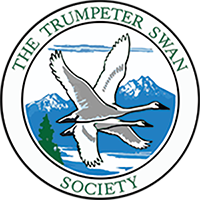Photograph by Margaret Smith
TRUMPETER SWAN INFORMATION
Our site is packed with swan information for all ages and levels of interests in Trumpeter Swans. When you join the Trumpeter Swan Society you will receive the most up-to-date swan information through our member newsletter Trumpetings, as well as exclusive updates and notices.
Don't forget to check out the following parts of our web site:
-
For information on how to identify Trumpeter, Tundra, and Mute Swans. Learn more about swan behavior.
-
This section is filled with information about swans including important links including where to see swans, articles, maps, swan events, research and papers.
-
Are you an educator looking for classroom ideas or information about swans to share with your students? Check this out!
COMPREHENSIVE SCIENTIFIC INFORMATION
The most up to date and most complete single sources of scientific information for all three species of North American Swans are the species accounts from The Birds of North America. This series is jointly published by The Academy of Natural Sciences, and The American Ornithologists' Union. Your local library, university, or natural history organization may have a subscription to this series. Single copies of the species profiles for the Trumpeter Swan (No. 105), Tundra Swan (No. 89), and Mute Swan (No. 273) can be purchased from Buteo Books, 3130 Laurel Road, Shipman, VA 22971. 800-722-2460 or 434-263-8671.
GENERAL SCIENTIFIC INFORMATION
-
This 8 page document written in 1995, includes excellent discussions of basic biology, historic and current distribution with very good range maps, a summary of restoration efforts in the Midwest, and much more. This is publication G3647 of the University of Wisconsin - Extension, written by Sumner Matteson, Scott Craven and Donna Compton. The Society gratefully acknowledges the University of Wisconsin Extension Service for permission to post this document on our web site.
-
This is the 2015 report by the U.S. Fish and Wildlife Service of all North America's Trumpeter Swan populations. The report is done every 5 years.

